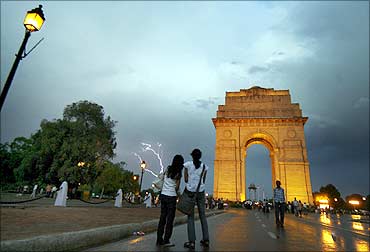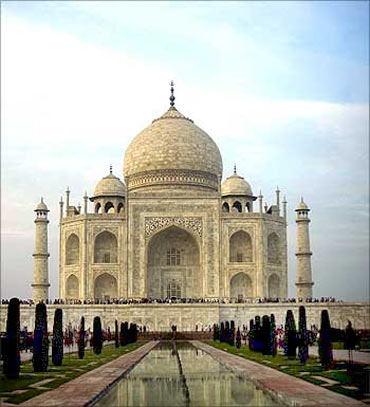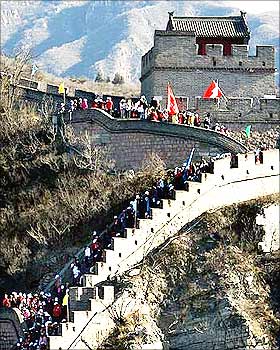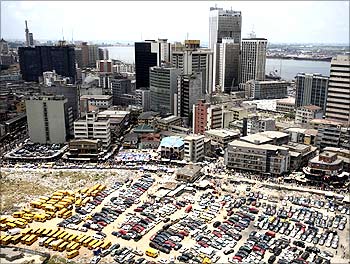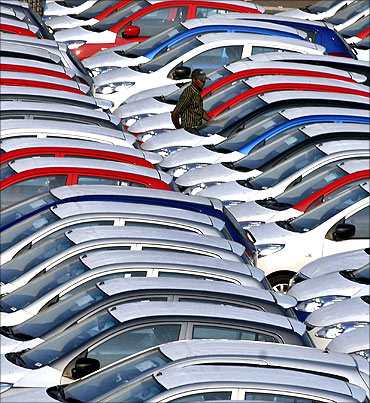 | « Back to article | Print this article |
Why India will be world's No. 1 economy by 2050
The 10 largest economies by 2050 (in trillion 2010 PPP dollars) will be very different from what they are now. Read on to find out which are these nations and why India will be the largest economy. . .
In view of its continuing robust growth, India is expected to be the world's largest economy by 2050, surpassing China and the United States, a Citi report said.
"China should overtake the US to become the largest economy in the world by 2020, then be overtaken by India by 2050," financial services group Citi said the report.
The estimates are based on Purchasing Power Parity (PPP), an economic growth indicator that takes into account the purchasing power of each country's currency, instead of the prevailing exchange rate conversion.
Indian economy is expected to be nearly $85.97 trillion on PPP basis by 2050 from $3.92 trillion in 2010, Citi said.
Going by the report, India would surpass the US -- currently the world's largest economy -- to become the second largest by 2040.
"We expect India to overtake Japan to become the third largest economy in the world by 2015," it noted.
In terms of PPP, Indian economy -- valued at $3.78 trillion -- was at the fourth place in 2009. The country was behind the US, China and Japan, according to the World Bank.
Click NEXT to read on . . .
Why India will be world's No. 1 economy by 2050
Citi pointed out that North America and Western Europe's share of world's real GDP (in terms of dollars calculated on PPP basis) is expected to fall from 41 per cent in 2010 to just 18 per cent in 2050.
During the same period, developing Asia's share is predicted to rise from 27 per cent to 49 per cent in 2050.
Citi emphasised that a number of major changes within a relative short time are required for India to meet future challenges.
Noting that India's infrastructure has to be improved, Citi said the country needs to relax its "hostile attitude towards FDI", if it is to reap the benefits of rapid cross-border technology transfer that China has benefited from so greatly.
"...a further round of serious deregulation of the domestic economy and further trade liberalisation are required," it noted.
The report said India's population of working age is expected to grow by 40.7 per cent between 2010 and 2050.
India has successfully raised its aggregate savings rate to levels that would allow sustained high levels of domestic capital formation (the domestic saving rate averaged 34.4 per cent over 2006-2009 and the gross domestic investment rate 32.4 per cent), the report added.
Click NEXT to read on . . .
Why India will be world's No. 1 economy by 2050
Growth until 2050 and its key drivers
Many potential drivers have been put forward. But at the highest level of aggregation, the taxonomy of potential growth drivers only has three categories: (1) initial conditions and the external environment, (2) institutions and (3) policies. Each of these three categories does, however, have a number of sub-categories.
The momentous shifts in economic weight and power are also evident in rankings of the largest economies by size of real GDP in 2010 PPP dollars.
Citi expects India to overtake Japan to become the third largest economy in the world by 2015, but otherwise forecast little change in the order of the ten largest economies over the next five years.
By 2020, China should have just overtaken the US to become the largest economy in the world, while Italy would have dropped out of the top ten, to be followed by France by 2030, the UK by 2040, and Germany by 2050.
By 2050, the make-up of the ten largest economies in the world should bear little resemblance to the one in 2010.
Click NEXT to read on . . .
Why India will be world's No. 1 economy by 2050
Bangladesh, China, Egypt, India, Indonesia, Iraq, Mongolia, Nigeria, Philippines, Sri Lanka and Vietnam have the most promising (per capita) growth prospects, according to Citi. And these are Citi's Global Growth Generator or 3G countries.
1. India: $85.97 trillion
Citi expects India's real per capita GDP to grow at 6.4% p.a. over the 40-year period between 2010 and 2050 (7.2% p.a. over the next 10 years and at rates of 7.7% p.a. between 2020 and 2030 and 5.2% p.a. between 2030 and 2050).
As a result, India is expected to become the largest economy in the world by 2050, overtaking China and the US in the process.
India starts way below the frontier: it ranks 54th in real per capita GDP, at $3,298 in 2010. It truly is an Emerging Market as regards the sectoral composition of its production and labour force, which are overwhelmingly rural.
Its demographic evolution is at least 35 years behind that of China with a high (but falling) birth rate and a large and growing population of young workers: India's population of working age is expected to grow by 40.7 per cent between 2010 and 2050.
Click NEXT to read on . . .
Why India will be world's No. 1 economy by 2050
India's assets are many: It has successfully raised its aggregate savings rate to levels that would allow sustained high levels of domestic capital formation (the domestic saving rate averaged 34.4 per cent over 2006-2009 and the gross domestic investment rate 32.4 per cent).
Its education system, while not without weaknesses, produces a large pool of cheap, internationally competitive, English-speaking graduates, allowing India to build up a comparative advantage in certain sectors, such as IT or business processes.
This 'demographic dividend' can, of course, become an economic curse if the young are not educated and trained properly and if the domestic capital formation rate is not high enough to create an adequate supply of productive jobs.
Click NEXT to read on . . .
Why India will be world's No. 1 economy by 2050
For India to meet that challenge, a number of major changes will have to occur in a relatively short period of time.
First, India's infrastructure has to be improved across the board.
Second, India has to move from a position of educating a limited number of youngsters very well but not the majority (especially females in rural areas and the lower castes almost everywhere) to one of educating all its youth properly.
Third, India needs to relax its hostile attitude towards FDI, if it is to reap the benefits of rapid cross-border technology transfer that China has benefited from so greatly.
Finally, a further round of serious deregulation of the domestic economy and further trade liberalisation are required. Pricing water, energy and other resources at full marginal social long-run cost, at least for all producers especially, in the case of water, those in the agricultural sector - or equivalent measures to ration the use of these essential scarce resources will be necessary to avoid an environmental block on economic growth.
Given these changes, India's growth rate during the next 20 or 30 years could be as high as those of China this past decade, and these prospects are reflected in India's 3G score of 0.71.
So check out which will be the other nations among the top 10 largest economies in the world (in trillion 2010 PPP dollars) in 2050.
Click NEXT to read on . . .
Why India will be world's No. 1 economy by 2050
2. China: $80.02 trillion
For China Citi predicts an average growth rate of 5.0 per cent p.a. for real per capita GDP over the period 2010 2050, lower than in the recent past, but still highly respectable - even more so after two decades of largely uninterrupted near double-digit increases.
China's real per capita GDP ranking in 2010 is 45th, at $7,430. This is quite far above the poorest countries now, but even more distant still from the rich industrial nations. A lot of convergence therefore remains to be done.
Click NEXT to read on . . .
Why India will be world's No. 1 economy by 2050
3. United States: $39.07 trillion
The US economy is the largest in the world currently, with an estimated 2008 gross domestic product (GDP) of $14.3 trillion (a quarter of nominal global GDP and a fifth of global GDP at purchasing power parity).
But its dominance is seen declining as nations like India and China show rapid and sustained growth to become the world leaders over the next four decades.
Click NEXT to read on . . .
Why India will be world's No. 1 economy by 2050
4. Indonesia: $13.93 trillion
Indonesia's predicted growth rate of per capita income from 2010 to 2050 is 5.6% pa. It currently ranks 50th in real per capita income, with a 2010 real per capita income level of $4,362, so there is plenty of potential for catch-up and convergence.
Indonesia's large population (233 million in 2010) is predicted to rise to 288 million in 2050. Its population of working age is expected to increase by 17.9 per cent over the same period.
Thus, demographics are a factor that should be working in Indonesia's favour to achieve China-like growth rates over the next 40 years.
Indonesia ranks high on the 3G Index, with a score of 0.72 for the Index excluding government consumption.
Click NEXT to read on . . .
Why India will be world's No. 1 economy by 2050
5. Brazil: $11.58 trillion
Brazil, with a 2011 population of 203.4 million, has traditional advanced EM demographics.
Brazil's public spending as a share of GDP is not too far below that of some of the West-European EU member states.
It also spends a rather small share of GDP on gross fixed investment (just 17,3 per cent of GDP during 2006-2009).
Given Brazil's low investment rate, its ambiguous attitude towards FDI (and the rapid technology transfer it permits), its fairly favourable demographics and the poor educational and training record of much of its population, Brazil's sustainable growth rate of real GDP per capita is estimated to be no more than 3.5 per cent p.a. between 2010 and 2050.
Click NEXT to read on . . .
Why India will be world's No. 1 economy by 2050
6. Nigeria: $9.51 trillion
Nigeria has been a classic example of the natural resource curse at work in the past, but is beginning to show signs of being able to solve the political economy problem of managing the exploitation of natural resource wealth. At 6.9% p.a. between 2010 and 2050, Citi expects average real per capita growth in Nigeria to be the highest among the countries in our sample.
It is blessed with natural resources, both renewable and non-renewable, even though those blessings have often turned to curses in the past. The policy environment and economic management have improved in recent years.
On the economic side, oil revenues are managed more prudently, with the existence of the excess crude account and the establishment of a sovereign wealth fund.
Click NEXT to read on . . .
Why India will be world's No. 1 economy by 2050
7. Russia: $7.77 trillion
Citi predicts 3.7 per cent real per capita GDP growth p.a. for Russia between 2010 and 2050. It is ranked 28th in our sample as regards real per capita GDP in 2010, with $15,701.
Russia is expected to have a population of 138.7 in 2011, which is declining at an annual rate of 0.5 per cent, due to a combination of a very low birth rate (a total fertility rate of 1.4) and an extremely low male life expectancy (for a country with its per capita income).
The country's booming natural resource sector allows it to paper over the large cracks in its economic edifice.
Click NEXT to read on . . .
Why India will be world's No. 1 economy by 2050
8. Mexico: $6.57 trillion
The economy of Mexico is today the 11th largest in the world. The country is well known for the quality of its car industry.
Mexico has at times been seen as a chronic economic underachiever, despite its favourable geography and demographics (a population size of 113.7 million and a total fertility rate of 2.3 in 2011), and despite an impressive series of economic reforms following the economic crisis of 1981-1985.
Mexico has the potential of being a Latin American success story surpassing even the growth performance of Brazil over the past decade.
Click NEXT to read on . . .
Why India will be world's No. 1 economy by 2050
9. Japan: $6.48 trillion
Japan today is a major economic power with world's second-largest economy by nominal GDP and the third largest in purchasing power parity.
It is also the world's fourth largest exporter and sixth largest importer. It is also the only Asian country in the G-8.
With GDP (PPP) of $4.356 trillion, Japan is a force to reckon with. However, it will see other nations overtake it over the next 40 years.
Click NEXT to read on . . .
Why India will be world's No. 1 economy by 2050
10. Egypt: $6.02 trillion
For Egypt, Citi expects a steadily rising growth rate for the next 40 years, averaging 5.0 per cent p.a. between 2010 and 2050.
Egypt ranked 48th in 2010 as regards real per capita GDP with $5,878.
Its population is expected to increase from 84.4 million in 2010 to 129.5 million in 2050 and the population of working age is expected to grow over the same period by 60.8 per cent.
The political revolution that swept aside the President Hosni Mubarak regime in February 2011 gives grounds for hope, but has not by itself solved the challenge of finding employment for the rapidly rising population.
After the political transformation that is to be expected, it will be the right time for far-reaching reform in the economic sphere as well, says Citi. And that is why it is optimistic about the prospects for Egypt.
And here's how India will generate sustained growth to reach the top . . . Click NEXT to read on . . .
Why India will be world's No. 1 economy by 2050
How India can generate sustained growth
The secret of achieving sustained high growth really is no secret at all. The fact that it is no secret does not mean, however, that it is easy to achieve, says the Citi report.
Citi says, growth should be easy for those starting out far behind, and lists out 17 reasons, all of which hold true for India:
1. Start poor: Far below the frontier levels of labour productivity and total factor productivity, and with a low stock of capital per worker.
2. Have a young population, that is, a large population of working age relative to the economically inactive population.
3. Educate the workers and future workers, men and women, to the maximal extent.
4. Let the best and brightest be educated abroad. They will come back if the country provides a reason for them to come back.
5. Create a professional, well-trained career civil service.
Click NEXT to read on . . .
Why India will be world's No. 1 economy by 2050
6. Strive for institutions that support the orderly succession of supreme political power. Avoid personalised autocracies.
7. Create a market economy and rely to the fullest possible extent on the profit motive for the provision of private (rival and excludable) goods and services.
8. Invite in FDI to the fullest extent. The technology, know-how and expertise it brings in are far more important than the equity funding these are bundled with.
9. Invite foreign businesses, entrepreneurs, managers and workers and open up to the global treasure chest of ideas.
10. Make sure you can achieve economies of scale, either by having a large domestic market or by opening up fully to world trade. Global export markets will allow you to exploit any economies of scale for traded goods and services. Competition from foreign imports and FDI will keep domestic producers in both traded and non-traded sectors on their toes.
11. Focus limited public spending on infrastructure, health, pre-school, primary and secondary education and vocational training and poverty relief.
Click NEXT to read on . . .
Why India will be world's No. 1 economy by 2050
12. Achieve high domestic investment rates and fund domestic capital formation mainly through domestic saving. Funding domestic capital formation with foreign saving/current account deficits always brings additional risks with it.
13. Liberalise the capital account slowly and deliberately, making sure the domestic banking sector and financial system can cope with the stresses and strains brought by financial openness. the way to minimise corruption is (a) to limit bureaucratic discretion (the source of corruption rents), (b) to maximise transparency and openness in government and (c) to encourage an open society, through diverse and critical media and a thriving civil society (to maximise the risk of exposure). When closer to the frontier, the quality of institutions matters more.
14. Make sure domestic financial market development and international financial integration do not get ahead of your supervisory and regulatory capacities.
15. Try to make sure that domestic savers have choices other than bank deposits and residential real estate. Consider the early liberalisation of portfolio investment abroad for this reason.
16. Encourage competition. Avoid man-made obstacles to entry and exit in labour markets and product markets, wherever possible. Avoid unnatural monopolies.
17. Regulate natural monopolies through transparent, accountable mechanisms.



